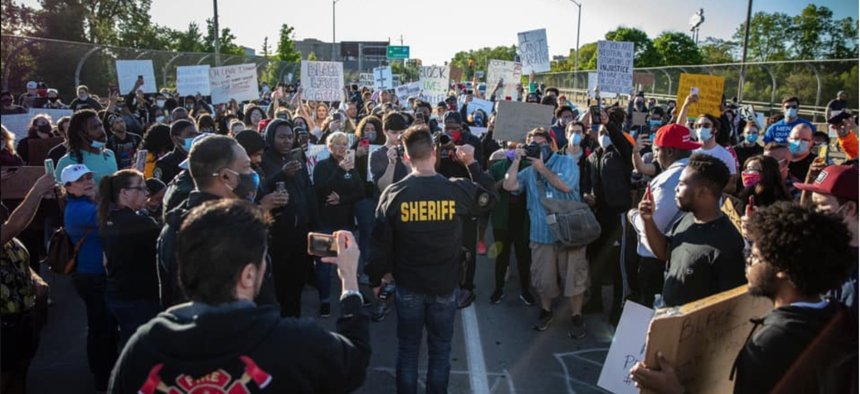'A Parade, Not A Protest': An Interview With Sheriff Who Took Off Riot Gear, Walked with Protesters

Sheriff Chris Swanson of Genesee County, Michigan, walks with protesters in Flint Township on May 30. Genesee County Sheriff's Office
Genesee County Sheriff Chris Swanson won attention for marching in solidarity with protesters in Flint Township, Michigan. He says he knows it will take more efforts to really improve many people's perceptions of law enforcement.
On May 30, Genesee County Sheriff Chris Swanson and a handful of law enforcement officers reported to a Target parking lot in Flint Township, Michigan, to join local police in overseeing a peaceful protest on the death of George Floyd.
About 100 people gathered in the parking lot and began marching, first east, then west, pausing southbound traffic on Interstate 69. And then, Swanson said, the group began heading toward the Flint Township Police Department.
“It was an intentional, deliberate walk toward the police department, which is far off the main drag,” said Swanson, who was appointed sheriff in January after 27 years in Genesee County. “The night before, we’d seen reports of the burning of a sheriff’s office in Oregon and of police precincts in Minneapolis, and at that point we just thought, ‘This could go bad.’”
The law enforcement command center told officers to ‘fortify the line.’ Police began suiting up in riot gear—helmets, shields, batons. Protesters began shouting. The tension was palpable. And then, out of the corner of his eye, Swanson saw a protester fist bump a police officer. He saw another protester go in for a hug.
“And I thought, ‘I could talk to these people,’” Swanson said. “So I took my helmet off and went into the crowd.”
Swanson hugged Jeffery Hawkins, a prominent black pastor. And then, in a moment that was captured on video and has since gone viral, he addressed the crowd.
“The only reason we’re here is to make sure that you’ve got a voice,” he said. “That’s it.”
Swanson told protesters that the police and deputies in attendance were nothing like Derek Chauvin, the white police officer who killed George Floyd by kneeling on his neck for 8 minutes and 46 seconds while Floyd repeatedly said, “I can’t breathe.”
“We go out there to help people, not to do that nonsense,” he said. “We want to be with y’all, for real. I took my helmet off. They laid their batons down. I want to make this a parade, not a protest. So listen, I’m just telling you, these cops love you. That cop over there hugs people, You tell us what you need.”
Quajuan Adams, one of the protesters, immediately replied.
“Walk with us!” he shouted.
The crowd joined in. “Walk with us!” they chanted.
Swanson pumped his arm.
“Let’s walk!” he replied.
Together, law enforcement officers and protesters walked for more than a mile back to the Target parking lot, where organizers addressed the crowd. Since then, the sheriff’s office and organizers have joined together for other events, including a solidarity march and other peaceful protests. There have been no arrests, no vandalism, no fires, and no property damage, Swanson said.
Across the country, some law enforcement officers have taken similar approaches. On Tuesday, protesters and police knelt and prayed together in Cleveland. In Denver, Police Chief Paul Fazen linked arms and marched with protesters, and in Atlanta, police knelt at the request of demonstrators.
But in other cities, police have used tear gas and pepper spray on peaceful demonstrations, and protesters in some places, including Virginia, have claimed that police knelt and prayed with them only to inflict violence hours later.
Former President Barack Obama this week praised police who interacted with protesters, noting that the “overwhelming majority” of demonstrators “have been peaceful, courageous, responsible, and inspiring. They deserve our respect and support, not condemnation—something that police in cities like Camden and Flint have commendably understood.”
But respecting protesters and marching with them is not a long-term solution, Swanson said. Since the protest-turned-parade, the sheriff has met with command staff and community leaders, including the head of the local chapter of Black Lives Matter, to discuss possible reforms.
“We need to lay out what our schedule is going to be to meet on a regular basis and what our command advance team is going to look like,” he said. “This wasn’t a one-and-done. May 30 was a great day, but it was just that—one day.”
Swanson said he believes that widespread police reform is possible—but it will require police to admit their faults, address systemic racism and adopt zero-tolerance policies for officers who disobey the law, take advantage of their power or use excessive force.
“Trust is done by action,” he said. “Police, from the top, have to build in-roads and change the hearts of cops first. The burden falls on police. I know it’s easy for me to say that, because I am one, but enough is enough. Wrong is wrong. How are we going to keep this from happening?”
Kate Elizabeth Queram is a staff correspondent for Route Fifty and is based in Washington, D.C.
NEXT STORY: COVID-19 Could Be End of Line for Some Regional Colleges





